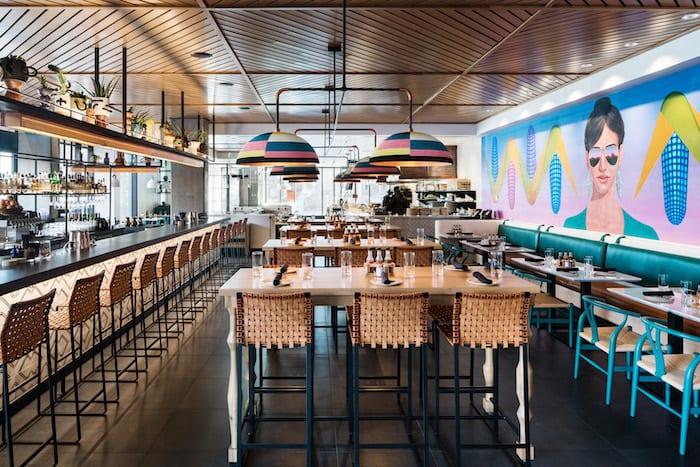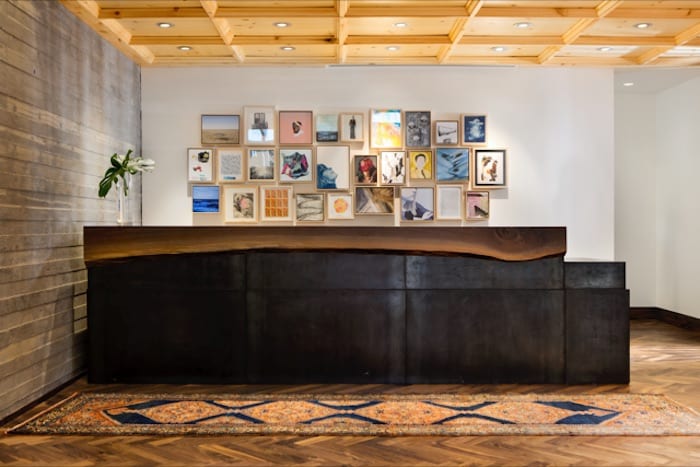Infusing Art to Enhance Private Development

BUILDING DIALOGUE: Art in Real Estate
You notice a thin white structure pouring down the side of a building and splashing to the ground like spilled milk. You smile and enter the alleyway. You turn a mysterious knob on the wall and are surprised to unlock the sounds of the Colorado Symphony. You enter the building to see a yarn-bombed tree and a gigantic wooden hand epitomizing hospitality. You just entered the Dairy Block in Lower Downtown Denver, one of many examples of leveraging the arts to enhance a space.
When art is thoughtfully integrated into developments, there is a mutually beneficial outcome that extends beyond the bottom line. Over the summer, Colorado Business Committee for the Arts hosted a forum to explore this business case for infusing art and creativity into private real estate development.
CBCA has been advancing Colorado’s creative economy by connecting business and the arts for over 30 years, accomplished through advocacy, research, training, volunteerism and arts engagement. In 2018, CBCA launched a new Arts + Industry Forum Series to examine the intersection between the arts and specific industry sectors. On Aug. 27, CBCA hosted an Arts + Real Estate Forum at the ART hotel, attended by nearly 100 people.
The forum panel included a combination of top Denver developers, consultants and artists. Through presentations and dialogue, they discussed the return-on-investment for art in placemaking, why art is a smart investment for real estate developers, and the various benefits and challenges for artists working with the private sector.
“In an increasingly competitive market, developers are looking for that little extra something that will help set them apart,” said Martha Weidmann, CEO at NINE dot ARTS, which is a corporate art consulting firm based in Denver. The firm is behind many of the spaces in Colorado and nationwide that inspire that unique “surprise and delight” factor, which fosters positive experiences and loyalty for customers and constituents. “Using a curated art program, we help define a space – whether that’s a corporate office building, hotel or luxury condominium – creating intrinsic value for the people who use it.
“Looking beyond the space, developers are also taking a more holistic approach to creating healthy environments designed to enrich people’s lives,” Weidmann added. “Similar to the benefits of incorporating environmentally friendly design elements, art has been shown to improve the health and wellbeing of the people who use the space. It’s even been shown to boost productivity and creativity in the workplace.”
As part of the Art House Townhome project, Mark Falcone (Continuum Partners) and Ellen Bruss (Ellen Bruss Design) gave Museum of Contemporary Art Denver land to build a new building. This brought an iconic, signature cultural institution into an evolving neighborhood and defined it.
Nearby, Continuum developed The Hotel Born next to Denver’s Union Station. Working with MCA Denver, Hotel Born showcases 700 works of original art throughout the space. Bruss mentions that “this has completely engaged our visitor, building long-term loyalty and creating a unique selling proposition for the Hotel.”
CBCA asserts that there’s an important difference between exploiting the arts and intentionally permeating it into the very nature of a development project to ensure a mutually beneficial partnership and sustainable impact.
East West Partners has focused on creating places that celebrate people and the relationships between them. “More than just something beautiful, art is also an important mouthpiece to express what a community is thinking and feeling,” said Amy Cara, managing partner at EWP. “Integrating the arts into our communities and creating structures to continue to maintain them is something that EWP has stood for since our inception in 1986.”
Putting art inside the spaces at EWP is only part of the equation. There is an imperative to engage the community in the creative process for generations to come. For example, the company’s Riverfront Park development led to the creation of PlatteForum, which connects youth with master artists from around the world to create together.
Next year, EWP will launch Union Hall, an arts and culture space in partnership with NINE dot ARTS at The Coloradan at Union Station.
“Our vision when creating Union Hall was to design a space that is a display and performance space, but is also a true cultural community partner that aims to advance the opportunities for emerging artists and ‘creatives,’” explains Cara.
Of course, there are challenges when real estate interests meet the arts. At CBCA’s Arts + Real Estate Forum, longtime Denver muralist, painter and sculptor Emanuel Martinez told heart-breaking stories of his public pieces that had been damaged by developers and careless construction workers.
Beyond respecting the physical aspects of art pieces and venues, there is a more significant responsibility to placemaking. This is not a transactional endeavor achieved in a vacuum. Placemaking also include place-preserving, sustaining and improving.
“Partnering with your local arts group and art district is a great way for real estate developers to connect deeper with the community they are about to become a part of,” said Tracy Weil, co-founder and creative director of the River North Arts District. The RiNo area, which is comprised of four different historic neighborhoods, can be considered “ground zero” for this conversation. By their very nature, the arts can be a way to tap into the soul of an existing community.
“When artists move into a neighborhood, values increase. Art and artists make interesting places,” added Bruss. “The challenge for placemakers is to ensure that artists can continue to live and work in these places.”
“As the (RiNo) district grows, we’ve worked with developers and newcomers letting them know the importance of having artists in our communities,” Weil explained. “I always say you can’t have an arts district without artists. It’s important to provide paid opportunities for artists and affordable space to work and live.”
The mutually beneficial business case is clear. Infusing the arts into private development fosters more unique and effective spaces that, if done thoughtfully, can advance the local creative community, which adds value and vitality to the surrounding area.
Published in the December 2018 issue of Building Dialogue.














